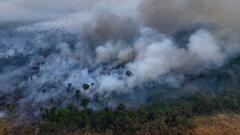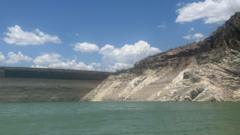A disturbing report reveals that tropical forests worldwide were lost at an alarming rate last year, with experts warning of potential irreversible damage. While some regions show positive trends, like Southeast Asia, the overall situation underscores the urgent need for effective climate policies.
Unprecedented Loss of Tropical Forests Recorded as Climate Woes Intensify

Unprecedented Loss of Tropical Forests Recorded as Climate Woes Intensify
New satellite analysis reports the fastest recorded destruction of tropical forests, driven primarily by fires and exacerbated by climate change.
In a concerning report worldwide, tropical forests – crucial for combating climate change – experienced their most significant loss ever last year, as detailed by new satellite analysis. Researchers estimate that in 2024, 67,000 square kilometers of these vital ecosystems vanished, an area comparable in size to the Republic of Ireland or roughly 18 football fields every minute.
Fires emerged as the primary catalyst for forest loss, surpassing agricultural land clearing for the first time on record, particularly affecting the Amazon amid its worst drought in years. The loss of these ancient forests raises critical concerns regarding their resilience in the face of a warming planet, with experts suggesting that certain regions may be nearing a “tipping point” leading to irreversible decline.
Professor Matthew Hansen, co-director of the GLAD laboratory at the University of Maryland, called the findings “frightening,” noting the risk of “savannisation” of the rainforest as old-growth forests transition permanently to savanna ecosystems. “Looking at the data, the theory becomes increasingly plausible,” he emphasized.
A separate study warned that significant dieback of the Amazon may occur if global warming exceeds the international goal of limiting temperature rises to 1.5 degrees Celsius. This scenario poses not only threats to the array of life in these biodiverse areas but could also have dire implications for global climate as the Amazon shifts from a carbon sink to a carbon emitter.
The recent drought and the El Niño weather pattern intensified fire conditions, with Brazil and Bolivia heavily impacted. Deliberate land-clearing fires complicate the situation, making it difficult to separate natural from anthropogenic factors. Experts now warn that we are entering a phase where intense fires could become prevalent, fundamentally altering the landscape.
The total loss of tropical forests resulted in an estimated release of 3.1 billion tonnes of greenhouse gases – equivalent to the emissions of the entire European Union. Yet, amid these dire statistics, some countries like Indonesia have seen a reduction in forest loss. Efforts to enforce stricter “no burning” laws in Southeast Asia have led to an 11% decline in the area of prime forest lost, proving that political will plays a crucial role in conservation.
However, experts caution that sustained success is crucial; recent fluctuations in forest loss in nations like Brazil highlight the need for continuous and consistent conservation policies. With the upcoming UN climate summit (COP30) set to take place in the Amazon, there is hope for fostering new collaborative efforts to safeguard these vital ecosystems, notably through financial incentives for countries that maintain their forests.
Experts like Rod Taylor emphasize that successful environmental conservation requires ongoing commitment, as present systems favor deforestation over preservation. The path forward remains a daunting challenge, as the world grapples with the consequences of rapid climate change on one of its most vital ecological resources.
Fires emerged as the primary catalyst for forest loss, surpassing agricultural land clearing for the first time on record, particularly affecting the Amazon amid its worst drought in years. The loss of these ancient forests raises critical concerns regarding their resilience in the face of a warming planet, with experts suggesting that certain regions may be nearing a “tipping point” leading to irreversible decline.
Professor Matthew Hansen, co-director of the GLAD laboratory at the University of Maryland, called the findings “frightening,” noting the risk of “savannisation” of the rainforest as old-growth forests transition permanently to savanna ecosystems. “Looking at the data, the theory becomes increasingly plausible,” he emphasized.
A separate study warned that significant dieback of the Amazon may occur if global warming exceeds the international goal of limiting temperature rises to 1.5 degrees Celsius. This scenario poses not only threats to the array of life in these biodiverse areas but could also have dire implications for global climate as the Amazon shifts from a carbon sink to a carbon emitter.
The recent drought and the El Niño weather pattern intensified fire conditions, with Brazil and Bolivia heavily impacted. Deliberate land-clearing fires complicate the situation, making it difficult to separate natural from anthropogenic factors. Experts now warn that we are entering a phase where intense fires could become prevalent, fundamentally altering the landscape.
The total loss of tropical forests resulted in an estimated release of 3.1 billion tonnes of greenhouse gases – equivalent to the emissions of the entire European Union. Yet, amid these dire statistics, some countries like Indonesia have seen a reduction in forest loss. Efforts to enforce stricter “no burning” laws in Southeast Asia have led to an 11% decline in the area of prime forest lost, proving that political will plays a crucial role in conservation.
However, experts caution that sustained success is crucial; recent fluctuations in forest loss in nations like Brazil highlight the need for continuous and consistent conservation policies. With the upcoming UN climate summit (COP30) set to take place in the Amazon, there is hope for fostering new collaborative efforts to safeguard these vital ecosystems, notably through financial incentives for countries that maintain their forests.
Experts like Rod Taylor emphasize that successful environmental conservation requires ongoing commitment, as present systems favor deforestation over preservation. The path forward remains a daunting challenge, as the world grapples with the consequences of rapid climate change on one of its most vital ecological resources.




















